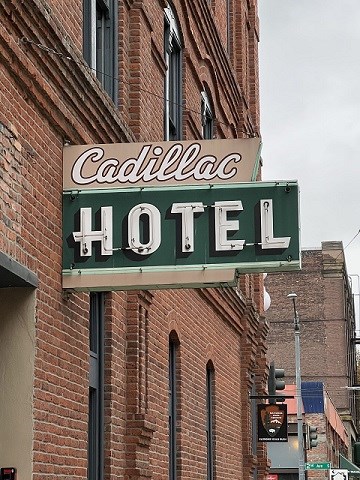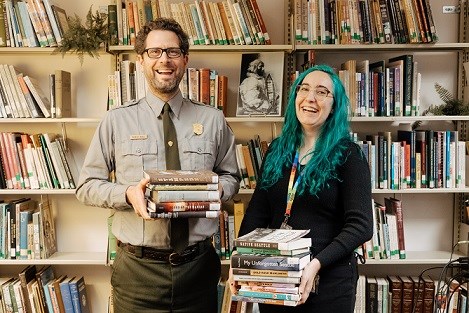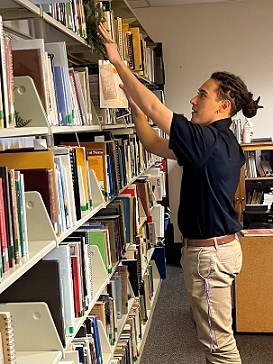Last updated: February 9, 2023
Article
Books and Buildings: Connecting the Past to the Present Through an Employee Library

Emma Rockenbeck
My mission at KLSE is to organize the employee library. The KLSE library currently holds a collection of books specifically related to KLSE, as well as books left over from the Pacific West Regional Library (PWSE). The Cadillac Hotel building previously housed the PWSE, which acted as a hub for all the national park libraries in the region. A full-time librarian worked there, cataloging books that were sent to them by employees from parks in the Pacific West Region. When PWSE was dissolved, many books remained on the shelves, interspersed with KLSE books. Effectively, this means that there are two libraries coexisting in a chaotic harmony on top of each other.
Charles Beall, the superintendent of KLSE, is enthusiastically heading the library cleanup project; his help has been invaluable to my mission. My main task is to catalog books into the NPS LIBRIS library system. This includes both new books and PWSE books that need to be moved into the KLSE collection. The process goes like this: Charles reviews a stack of books to make sure they are a good fit for our collection, then I enter them into NPS LIBRIS. After a batch of books is cataloged, I run a label report, print a set of labels, and then attach labels to the spines and card pockets on the inside front cover of the books. Finally, I enlist the help of other on-site Northwest Youth Corps interns to shelve the books. When I have questions, I ask the incredibly knowledgeable and helpful staff at the NPS Library Information Management Program for assistance.

Kelseyanne Johnson
The scope of collections for the museum was based on the original mission of KLSE. In 1976 Congress established Klondike Gold Rush National Historical Park. This park included three units in Alaska and one in Seattle, and was intended to “preserve in public ownership for the benefit and inspiration of the people of the United States, historic structures and trails associated with the Klondike Gold Rush of 1898.” This created a management challenge due to the park having sites in both the Alaska and Pacific West regions of the National Park Service. Eventually KLSE administratively separated from the Alaska units, giving rise to new responsibilities and opportunities, and altering the original scope of library collections that seek to benefit KLSE employees and partners throughout their work.
KLSE moved into the historic Cadillac Hotel building in 2006. The first floor and basement level of the building is the public-facing visitor center and Klondike Gold Rush Museum. The second floor houses the Pacific West Region Lands Office, the Washington Office of the Park Cultural Landscapes Program, and NPS’s cooperating association – Discover Northwest. On the third floor are the offices for KLSE staff. This includes the interpretive rangers and staff who run the museum, the staff who run youth and community outreach programs, interns, Charles Beall, and sometimes Brooke Childrey, the museum curator for Mount Rainier National Park, who supports KLSE. The third floor also houses the library.

Emma Rockenbeck
Because KLSE is in the heart of Seattle, the largest and most densely populated city in the Pacific Northwest region, the National Park Service recognized the role KLSE could play in connecting youth and families to their public lands. Seattle is surrounded by large national parks in all directions – North Cascades National Park, Olympic National Park, and Mount Rainier National Park – however, many of the people who live in Seattle are removed from these remote and wild places. For years KLSE has served as a connection between these national parks (and other public lands) and the urban center of Seattle. KLSE manages the Outdoor Recreation Information Center, a community resource inside the REI Seattle flagship store that offers trip planning assistance for safe and enjoyable public lands recreation throughout the Pacific Northwest. KLSE also participates in the Trails & Rails partnership with Amtrak by managing volunteers who educate travelers on the natural and cultural history that is visible on train routes between Seattle and Portland and Seattle and Wenatchee.
The mission of KLSE as a park is expanding and growing. As a result, the parameters Charles and I are considering when organizing the employee library must expand as well. Charles is excited to cultivate a collection of resources that focus on community building in order to support KLSE employees and partners in their engagement with Seattle area communities. The library is now incorporating books about leadership, education, race, gender, class, oppression, and the history of marginalized communities in Seattle (especially books written by people from these communities) into the KLSE Employee Library. I am excited and honored to be a part of this on-going project.
Article written by Emma Rockenbeck
for "A Day in the Life of a Fellow" Article Series
National Park Service - Workforce Management Fellow
in Partnership with Northwest Youth Corps (NYC)
If you live in or are visiting Seattle, the Klondike Gold Rush Museum is well worth a visit!
Use the following links to learn more about the organizations and resources mentioned in this article:
Klondike Gold Rush Museum
Bainbridge Island Japanese American Exclusion Memorial
Outdoor Recreation Center in REI
Wing Luke Museum of the Asian Pacific American Experience
Trails & Rails
*Author's name "bell hooks" has been intentionally left in lower case
for "A Day in the Life of a Fellow" Article Series
National Park Service - Workforce Management Fellow
in Partnership with Northwest Youth Corps (NYC)
If you live in or are visiting Seattle, the Klondike Gold Rush Museum is well worth a visit!
Use the following links to learn more about the organizations and resources mentioned in this article:
Klondike Gold Rush Museum
Bainbridge Island Japanese American Exclusion Memorial
Outdoor Recreation Center in REI
Wing Luke Museum of the Asian Pacific American Experience
Trails & Rails
*Author's name "bell hooks" has been intentionally left in lower case
Tags
- klondike gold rush national historical park
- klondike gold rush - seattle unit national historical park
- fellowships
- internships
- klondike gold rush national historical park
- klondike
- museum
- library
- seattle
- bainbridge island japanese american exclusion memorial
- minidoka national historic site
- minidoka
- gold rush
- klondike gold rush
- klse
- wing luke museum
- trails and rails
- international district
- seattle washington
- japanese american history
- history
- asian american history
- asian american
- pioneer square
- pacific northwest
- japanese american
- preservation
- building preservation
- artifact preservation
- book
- collections
- cultural preservation
